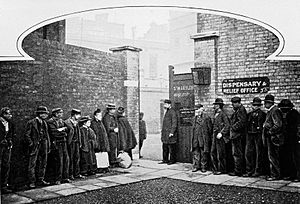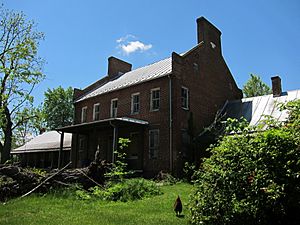Poorhouse facts for kids
A poorhouse or workhouse was a place run by the government, usually a county or city, to help and house people who were poor or couldn't take care of themselves. These places offered shelter and sometimes food and work to those in need.
Contents
What were Workhouses?
In countries like England, Wales, and Ireland, these places were often called "workhouses." Long ago, before special laws were made to help the poor, each local area (called a parish) had its own workhouse. These were often simple farms where people living there would work on the farm or help maintain local roads. An example of such a place is Strand House in East Sussex, England.
During the early Victorian era (a time when Queen Victoria ruled Britain, from 1837 to 1901), many people thought being poor was something to be ashamed of. Famous writer Charles Dickens wrote about workhouses, showing them as tough places. Sometimes, whole families lived there, but men and women were often kept separate and couldn't talk to each other. People living in workhouses had to do manual labor, and sometimes they even faced physical punishment.
These workhouse systems became more common after the Poor Law Amendment Act 1834 was passed in The United Kingdom. This law aimed to lower the cost of helping the poor. It also hoped to reduce the number of beggars and encourage people to work harder to support themselves.
Poor Farms in North America
In the United States, poorhouses were most common in the 1800s and early 1900s. They were often built on large pieces of land called "poor farms." People who were able to work were expected to help out on these farms. Sometimes, a poorhouse might even be next to a prison farm or other public buildings.
Poor farms were run by county or town governments. They supported people who were very poor, especially the elderly and those with disabilities. These farms were usually managed by people called "Superintendents of the Poor."
Most poor farms grew their own food, like crops and raised animals. Residents were expected to work as much as their health allowed. This included working in the fields or helping with chores inside the house and caring for others. The rules were very strict, and living conditions were basic.
The idea of poor farms came from the American tradition of local county governments providing social help. For many years, the federal government did not get involved in social welfare. This changed after the Social Security Act was passed in 1935. This act created programs like Social Security, which helped people financially. Because of this, most poor farms in the U.S. closed by the 1950s. Today, help for the poor comes from county, state, and federal governments. Poor farms have been replaced by things like subsidized housing and homeless shelters.
Poor Farms in Canada
In Canada, the poorhouse with a farm attached was also a common model. People often believed that poverty was a moral failing that could be fixed through hard work and order.
One of the oldest government-supported poorhouses in Canada that is still standing today is in Southern Ontario, between Fergus and Elora. This building, called the Wellington County House of Industry and Refuge, opened in 1877. Over the years, it housed about 1,500 people who were very poor, old, sick, or disabled.
The house had 60 beds for residents and was surrounded by a 30-acre farm. The farm had a barn for animals and grew some of the food for the 70 residents and staff. It also provided work for them. Others worked inside the house. A hospital was added in 1892. There is also a cemetery nearby with 271 graves. In 1947, the House became a home for the elderly. In 1975, the building reopened as the Wellington County Museum and Archives, which is now one of the National Historic Sites of Canada.
Images for kids
See also












